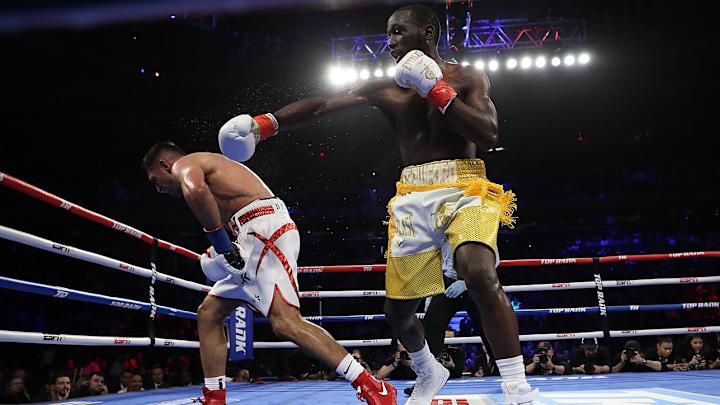Amir Khan’s Loss to Terence Crawford Isn’t Stunning—It’s How it Happened

NEW YORK — Amir Khan has been an Olympic medalist, a world champion, an avoided fighter and one willing to take on all comers.
After Saturday, there will be many that brand him with another label.
Quitter.
There’s no other way to describe what Khan did on at Madison Square Garden on Saturday, when he stepped into the ring with 147-pound titleholder Terence Crawford in arguably the biggest fight of his professional career. At 32 and nearly three years removed from a devastating knockout loss to Saul Alvarez, this could have been Khan’s last chance.
And when adversity hit, Khan bailed out.
Crazy. Khan was nearly knocked out in the first round, when a straight right hand from Crawford sent him twisting to the canvas. Had the round gone 10 seconds longer, he likely would have been. He rallied over the next few rounds, and connected with a few flurries, though he never had Crawford in trouble. In the sixth round, while battling in close, Crawford drilled Khan below the belt.
Khan doubled over, leaning against the ropes in his corner.
And then his trainer, Virgil Hunter, did something he stunning: he threw in the towel.
Incredible. By rule, Khan had five minutes to recover from the accidental foul. He appeared to take less than three. At the instructions of the corner, the referee stopped the fight. By rule, Crawford officially won by TKO.
So—what happened?
“He was hit low,” Hunter told SI.com. “The replay showed he was really hit low. Sometimes five minutes are not enough. Scientific studies have shown that a punch like that can totally incapacitate you. It was obvious that he was in pain. Amir has never shown any tendency to quit in a fight. I asked him if he could continue, he said no.”
So why not wait the full five minutes?
“Well I think it went three minutes, at least,” Hunter said. “And he was still in excruciating pain. Why send him out there again. You get hit there in the right way, you’re done. I had to take his word for it.
Was Khan looking for a way out?
“Why should he?” asked Hunter. “He was starting to get a rhythm going. I felt like he was inching his way. Not winning the rounds, but he was making the rounds more competitive. Why would he be looking for a way out?”
In the corner, Khan seemed to be complaining about hand issues. Did that have anything to do with it?
“He’s been dealing with a bad elbow, bone chips in the elbow ever since he came to camp,” Hunter said. “We did what we could to treat it. It didn’t really respond. But that wasn’t the reason why the fight was stopped. But he wasn’t fighting at 100%.”
Realistically, Khan had little chance to win. He was something of an unknown coming into this fight. At his best, Khan was gifted with blurring hand speed and sharp power. His shaky chin often got him into trouble. But no one knew what Khan was coming into this fight. He had two meaningless wins in the last year, a first–round blowout over Phil Lo Greco and a lopsided decision win over Samuel Vargas, a fight that saw Khan hit the canvas in the second round.
Early, it was clear Khan wasn’t going to be able to compete. Sitting ringside, Paulie Malignaggi watched a Khan he was unfamiliar with. Nine years ago Khan stopped Malignaggi. That Khan, Malignaggi said, “threw combinations with his legs in sync with his arms. The guy I saw tonight was kind of clumsy. He didn’t have any legs. When your arms and legs are not in sync, for a fighter like Khan, you have problems.”
Said Crawford, “[Jose] Benavidez and [Yuri] Gamboa were 10 times faster than him.”
At the post fight press conference, Khan was defiant. He denied quitting. He said he never would. He said he would rather be knocked out in the ring than quit before the final bell. His face was badly bruised from the 41 power shots Crawford connected on Khan’s skull. He nursed his injured arm while admitting only that there were some problems in camp.
There will be no rematch. Both fighters will move on. Crawford all but pleaded for a unification fight with Errol Spence Jr., in what would be one of the most anticipated fights in boxing. His promoter, Bob Arum, called for a boycott of Al Haymon shows until Haymon, Spence’s manager, makes a Spence-Crawford fight. If a Spence fight can’t be made—and it is highly unlikely, at least this year—Crawford’s options are limited.
He has more than Khan, though. Khan had hoped this fight would springboard him back into boxing’s pound-for-pound rankings. He had chased the likes of Floyd Mayweather and Manny Pacquiao for years. He begged to face the best. This was his chance to prove himself. Instead, it was a disaster. A much talked about fight with Kell Brook could still happen, but Khan will have a hard time shaking the perception that he quit, something Brook, who has been enraged by Khan’s refusal to face him, will most assuredly use against him.
Khan has had to rebuild, more than once. But this time will be more challenging. Khan has lost before, but he has always gone out on his shield—or, more precisely, his back. Not Saturday. Khan didn’t win the fight. Worse, it appeared he didn’t want to fight.
